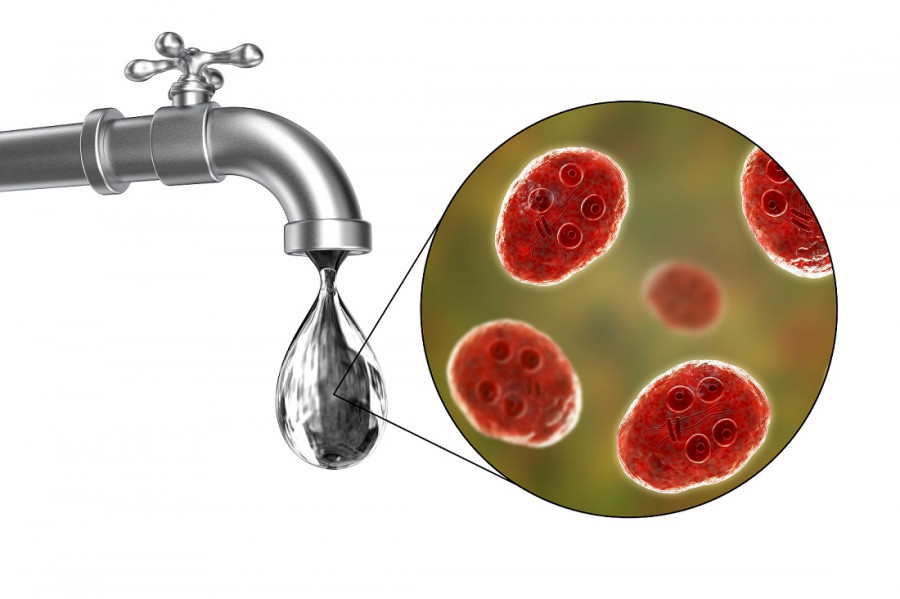Columns
New transmission route for an old disease
Cholera can cause dehydration that can lead to kidney failure, shock and even death.
Dr Sher Bahadur Pun
Over the past few days, the number of cases with acute diarrhoea has been increasing gradually in the community. Most patients have experienced severe watery stools more than a dozen times within several hours. Moreover, it has been noted that these watery stools have been seen one after another among family members at intervals of a few days. On June 16 last year, the first case of cholera was officially reported at Shukraraj Tropical and Infectious Disease Hospital, meaning cholera may appear and spread anytime and anywhere in the coming days.
Cholera is an acute diarrhoeal illness caused by the bacterium Vibrio cholerae. Two serogroups O1 and O139 (out of more than 200 serogroups) produce cholera-toxin and can cause severe life-threatening diarrhoeal illness; and are found to be associated with widespread outbreaks worldwide. Serogroup O1 is further divided into three serotypes known as “Ogawa”, “Inaba” and “Hikojima”. It has two biotypes “El tor” and “Classical”. Serogroup O1, Ogawa serotype and biotype El tor are found to be responsible for most of the frequent cholera outbreaks in Nepal.
Researchers believe that the Classical biotype is extinct, since cases related to it have not been reported or documented in the past several years. It is, however, worth mentioning here that for the first time, I have reported the Classical biotype having been discovered in cholera patients during the 2012 study in Nepal. Previous studies have shown that the Classical biotype is likely to cause more severe diseases compared to the El tor biotype. Thus, the Nepal study has thrown up a question regarding the existence of the Classical biotype of vibrio cholera, and this requires further investigation. A study conducted by a Japan-Nepal research team analysed sewage water from various locations of Kathmandu Valley in 2008 (June to September) and found multiple serotypes and biotypes of cholera, and warned of possible diarrhoeal outbreaks due to lack of safe drinking water and personal hygiene.
In 2015, for the first time, I identified/observed cholera in admitted patients who had been consuming jar water—a new but unexpected route of transmission of cholera infection. Jar water is generally thought to be clean, safe and ready to drink, and is now becoming the most common drinking water in Nepal. A couple of years ago, the Nepal Academy of Science and Technology (NAST) did surveillance on the commercial jar and bottled water sold in the market, and found medically harmful coliform bacteria which are responsible for diarrhoeal outbreaks each year. Based on this information, it is most likely that the residents of Kathmandu Valley are consuming contaminated drinking water causing diarrhoeal illnesses that may potentially increase in the coming days as the bottled water sold in the market is not being checked by the concerned authorities.
Cholera can be fatal within hours if left untreated. In 2021, a cholera outbreak occurred in Krishnanagar Municipality, Kapilvastu district where four people out of the 885 cases died of diarrhoea. All four patients did not reach health care facilities or were unable to receive proper treatment on time, meaning severe cholera can rapidly reach fatal levels if not treated promptly. In 2022, the first cholera patient admitted to our hospital showed symptoms after consuming uncooked food. These symptoms included severe watery stools and vomiting (multiple episodes), approximately 6-8 hours after eating. Cholera symptoms can appear within a few hours and as late as five days after eating or drinking contaminated food or water.
Profuse watery stool (rice-water stools), vomiting, abdominal or leg cramps, and restlessness are the main symptoms of severe cholera. Cholera can cause severe dehydration that can lead to kidney failure, shock and in the worst case, death. Severe cholera can be seen in 10-20 percent of the patients. Some studies have shown a relationship between blood type O and severe cholera. An asymptomatic cholera patient can spread bacteria up to 10 days after infection. Laboratory confirmation by culture or polymerase chain reaction (PCR) method of the clinically suspected cases or positive rapid diagnostic test (RDT) is needed to confirm a cholera outbreak.
Observation of cholera outbreak during the past nine-year period (2010-19) showed an interesting but unexpected shifting seasonal trend in Nepal. In 2010, a cholera outbreak occurred in the third week of August. Now it has been appearing earlier in April. Currently, the reason for the shifting seasonal trend of cholera in Nepal is not well known or studied; however, some studies pointed to global warming as a cause of this shifting trend. Based on this observation, a cholera outbreak may occur anytime, anywhere and spread rapidly around the country in the coming days. Thus, proper surveillance of commercially bottled water needs to be conducted by the concerned authorities immediately.
Besides preventive measures, vaccines can be considered as another option to mitigate severe cholera. Currently, the World Health Organisation (WHO) has made recommendations on the use of three pre-qualified oral cholera vaccines (Dukoral, Shanchol and Euvicol), especially in areas that have a high risk of cholera transmissions or outbreaks. Unfortunately, vaccines against cholera are not readily available at health care centres as cholera outbreaks occur almost every year in Nepal. In fact, most of the Nepali people are not even aware of the availability of these cholera vaccines, further spreading outbreaks around the country. Thus, the government of Nepal must initiate and provide cholera vaccines in sectors with a high possibility of an outbreak, especially in populated areas or cities.
To sum up, cholera is a severe diarrhoeal illness, and it can be fatal if not treated within hours. Over the last few years, bottled water has become more common in Nepal. Unfortunately, it has also become one of the main routes of cholera transmission in our country.




 14.12°C Kathmandu
14.12°C Kathmandu















